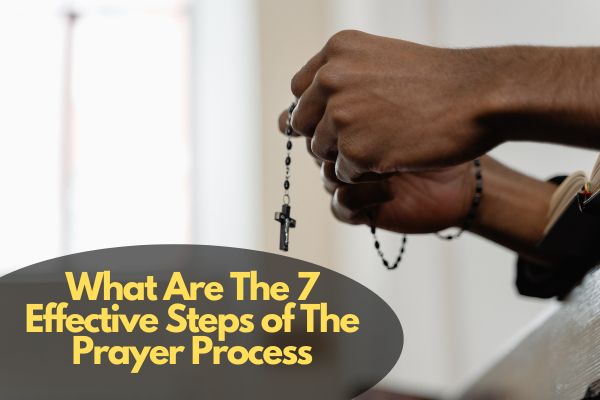What Are The 7 Effective Steps of The Prayer Process? The prayer process is not merely a ritualistic routine but a dynamic engagement of the heart, mind, and spirit. This article explores the steps of the prayer process, unravelling the layers of meaning, significance, and spiritual enrichment that each step unfolds.
Explore the sacred journey with insightful steps of the prayer process. Deepen your spiritual connection through this transformative guide. Embarking on the journey of prayer is a profound and transformative experience that connects individuals with the divine. Amid life’s challenges, joys, and uncertainties, the act of prayer serves as a guiding compass, offering solace, strength, and communion with a higher power.
Whether you are a seasoned practitioner or a novice seeker, understanding these steps can deepen your connection with the divine and enhance the transformative power of prayer in your life.
What Are The 7 Effective Steps of The Prayer Process
Prayer, a universal and deeply personal practice, serves as a bridge between the earthly and the divine. It is a profound means of communication with the sacred, offering solace, guidance, and a sense of connection. While prayer takes on various forms across different faiths and traditions, the fundamental steps of the prayer process share common threads that weave through the fabric of spiritual expression. In this exploration, we illuminate the query “What Are The 7 Effective Steps of The Prayer Process”, and the essential steps that characterize the prayer process, providing insights into this sacred journey.
1. Preparation and Presence:
The first step in the prayer process involves creating an environment conducive to spiritual connection. This often includes finding a quiet space, centring oneself, and cultivating an atmosphere of reverence. The goal is to transition from the mundane to the sacred, fostering a sense of presence that allows the individual to enter into a deeper state of awareness.
2. Invocation and Addressing the Divine:
With a heart attuned to the sacred, the next step involves invoking the presence of the divine. This may take the form of addressing a specific deity, higher power, or the divine essence within. Whether through recitation, contemplation, or silent invocation, this step establishes a direct line of communication with the sacred realm.
3. Expressing Gratitude:
Before you see the answer to your request, praise God. Praise God because you see the answer with spiritual eyes—the eye of faith. Praise is the ultimate form of prayer and demonstrates your faith in action. It also silences the adversary who seeks to steal your delight (Hebrews 13:15). Gratitude serves as a cornerstone in the prayer process. Expressing thanks for the blessings, experiences, and moments of grace in one’s life establishes a positive and humble attitude. Gratitude opens the heart, creating a receptive space for the divine presence and fostering a sense of appreciation for the interconnectedness of all existence.
4. Confession and Seeking Forgiveness:
Many prayer traditions include a step of confession and seeking forgiveness.
The Bible, in Colossians 3:13, imparts a profound teaching on forgiveness, emphasizing the transformative power of extending grace to others as we have received it from the Divine. This verse encapsulates a fundamental principle that runs through various passages in the Bible — the call for believers to embody the spirit of forgiveness in their interactions with fellow human beings.
Forgiving “as the Lord forgave you” implies unqualified, unselfish, and limitless forgiveness. As revealed throughout the Bible, God’s forgiveness is not conditional on our merit, but rather a demonstration of divine love and compassion. Similarly, believers are obligated to provide forgiveness not based on the offender’s worth, but as a show of love and adherence to Christ’s teachings.
This self-reflective practice allows individuals to acknowledge personal shortcomings, mistakes, and transgressions. Seeking forgiveness is not only an act of humility but also a transformative step toward personal growth and spiritual cleansing.
5. Supplication and Petition:
A central aspect of prayer involves making requests or seeking divine intervention. Whether asking for guidance, strength, healing, or blessings, this step of supplication allows individuals to articulate their needs, desires, and hopes. It is a moment of vulnerability, surrender, and trust in the divine wisdom.
6. Meditation and Contemplation:
Moving beyond words, the prayer process often includes moments of silence, meditation, or contemplation. This step allows individuals to listen for the divine voice, attune to inner guidance, and enter into a state of communion with the sacred. It is a time of receptivity, stillness, and openness to the mysteries of the divine.
7. Closing, Blessing, and Reflecting As a Newman:
As the prayer process nears its conclusion, individuals often offer closing words or blessings. This step serves to seal the sacred connection established during the prayer, expressing a sense of gratitude for the opportunity to commune with the divine. It marks the transition from the sacred space back into the rhythms of daily life.
The final step involves reflecting on the prayer experience and integrating its insights into daily living. This self-reflection may include a review of the prayers offered, insights gained, and a commitment to embody the qualities cultivated during the prayer process. It serves as a bridge between the sacred and the secular, bringing the transformative power of prayer into everyday existence.
Conclusion
The phases of the prayer process work together to generate a song that is in tune with the divine knowledge and the aspirations of the heart, creating a symphony of faith and spiritual contact. As we navigate through the foundations, intentions, and various dimensions of prayer, we find a sacred space where the mundane meets the divine.
In conclusion, the query “What Are The 7 Effective Steps of The Prayer Process?” forms a spiritual roadmap, guiding individuals on a journey of connection, reflection, and transformation. While the specifics may vary across religious traditions, the essence remains—a sacred dialogue that transcends the boundaries of the material world. The prayer process is a dynamic and evolving practice, offering a timeless pathway for seekers to deepen their spiritual connection and cultivate a richer understanding of the divine.
Each step is a stepping stone towards a more profound understanding of ourselves, our purpose, and our relationship with the divine. In concluding this exploration, may the steps of the prayer process be a continuous source of inspiration, guidance, and solace, leading us on a transformative journey of spiritual growth and communion with the sacred.






